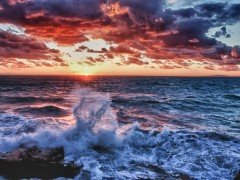
High Dynamic Range photography is a very interesting aspect of photography. HDR photos being out the never-see-before details in the photograph making it life-like. This post is dedicated to the subject and is an effort to shed light on some of the lesser known truths about HDR photography.
What is dynamic range?
Dynamic Range of a device signifies the ratio between the maximum and minimum brightness levels that a device can capture or render. Dynamic range is measured in stops or EV (exposure value) which is expressed in the power of two. Thus a dynamic range of 10 stops is 210 = 1024 levels of brightness.
The dynamic range of the camera
Typically DSRLs have a dynamic range of 5-6 stops but it varies by the manufacturer. Film cameras have a higher dynamic range with black and white topping out at 9 stops. Thus from all the available levels of light in the original scene the cameras can only capture a limited range.

When you change the exposure (aperture, shutterspeed, ISO) you are basically shifting the dynamic range of the camera towards or away from the dark or the bright side thereby being able to capture daytime scenes or nighttime scenes. Due to the limited dynamic range of the camera, the less-than-dark levels of light are rendered dark and less-than-bright levels are rendered bright and the clipping occurs as evident in the histogram. This is better explained through an analogy. The human eye has an approximate dynamic range of 24 stops which is still limited as compared to the available light. The eye adapts to the available light depending on whether it is dark or bright which is similar to what happens when you vary the exposure of the camera. When you look at the sun the eyes are blinded which is what happens to the camera when it meters for the shadows and the highlights bloom out. On the other hand once your eyes adapt to seeing the sun you are again blinded when you look away. The camera similarly meters the underexposed as dark when trying to expose for the highlights.
Reproducing an HDR scene
There are two phases to this the first being capturing and the second being rendering. Ideally in order to reproduce a scene with its complete dynamic range you need a device that is not blinded by the sun or the shadows. You will need a monitor that can shine as bright as the sun (the sun being the brightest natural source of light and thus referenced as the upper limit) and render the darkest black levels in the shadows.
The dynamic range of the monitor
The term used to measure the dynamic range of the monitors is the contrast ratio however all monitors render 256 levels of brightness which is 28 = 256 or 8 stops of dynamic range. (Another way to verify is to see how the rgb color space works – 0 is black while 255 is white).
The secret behind the so-called HDRs
On the face of it, it is nothing more than illusion. With the limited dynamic range of cameras and monitors what you see as HDR is nothing more than image manipulation. To render these HDRs multiple exposures are taken from a camera at varying stops (EVs). Thus each shot captures a different dynamic range. These are then blended to compose a single image which contains a greater level of dynamic range but still pretty much useless because of the bottleneck the dynamic range of the monitor poses. To get around this “Tone Mapping” is used more popularly known as curve manipulation is Photoshop. This is nothing more than mapping the darker areas in the image to render brighter thus visible on the monitor.
Making a real HDR
People have managed to capture a larger dynamic range with multiple exposure however the rendering is limited by the performance of the monitors. But technology is evolving fast. Brightside has been working on something promising. It has come out with a monitor which uses individual LEDs instead of a single bulb back-lighting the screen. This results in a very high bright screen with a very high contrast ratio. As time passes we’ll see more of such devices. Till then you can play around with the so called High Dynamic Range images which are nothing more than surreal looking illusions of tone mapping or the more toned down, muted and realistic HDRs which look closer.


Wow, it does sound pretty complicated. Thanks for the explanation.